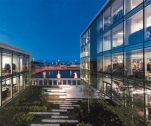BESTSELLER - Elegant Simplicity

Aarhus is the second largest city in Denmark after Copenhagen. It is beautiful, comfortable for living and especially focused on young people, as most of the schools and universities in the country are located here. Aarhus has always been a rich place, but it nevertheless did not have enough capital’s gloss. Because of this reason Copenhagen was always considering it a younger brother, who lives “somewhere out there, on the Jutland peninsula.”
From the Danish capital it can be reached by train, bus, car, plane, or the most enjoyable way- by sea. Despite the fact that the latter variant is mainly used by residents and tourists compared to the other options, as well as forming the “face of the city” from the water, coastline still looked very industrial, shaped by silhouettes of numerous cranes and containers for quite a long time.
Founded by the Vikings in 800’s, today the port handles nearly 66 percent of the container traffic of Denmark and is the most important one in northern Europe. Seemed that the city authorities were trying to ignore this unsightly area until 1997 when was made a decision to change business direction of the inner zone of the port to residential, social, cultural, commercial and recreational. The task was not only to integrate the formerly isolated area in the urban environment, but to make it a center of attraction and reunit at last the city with water.
Like most of the things in Denmark, the project of Aarhus port renovation had to fulfill a number of criteria: to take into account and respect the human scale, to provide advanced infrastructure, high-quality architecture, to develop economic and commercial interests of the city and of course most important – not to destroy the harmony of environment and ecology. The last requirement, by the way, in a sense helped to be solved the project’s situation by itself, because, for instance, construction materials could easily be delivered by sea, reducing by that emissions from the land delivery process.
Full content of this issue you can read here
The full version of the article can be read in our printed issue, also you can subscribe to the web-version of the magazine
 Text: Elizaveta Klepanova
Text: Elizaveta Klepanova
Illustrative materials provided by C.F.Møller


